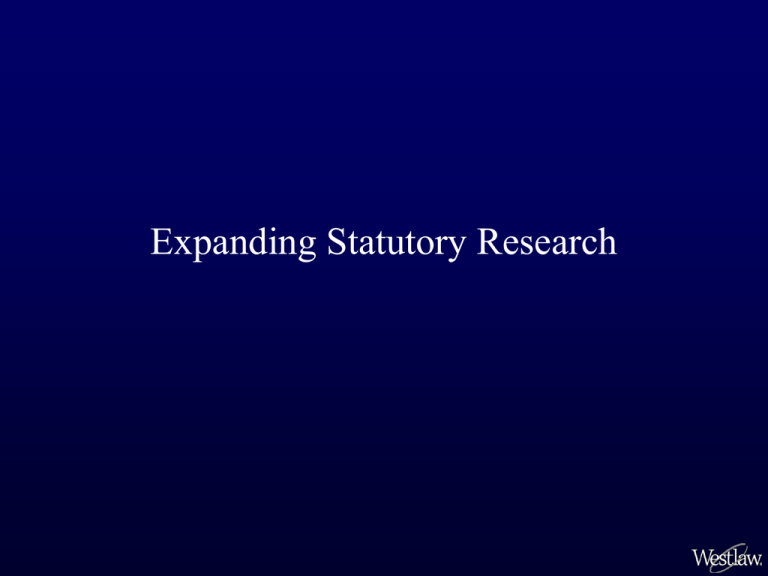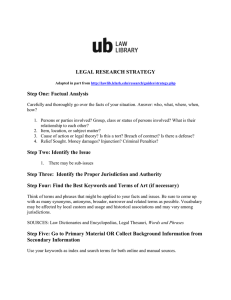Expanding Statutory Research
advertisement

Expanding Statutory Research Expanding Statutory Research • KeyCite Citing References • Case law that has interpreted or applied the statute – Annotations (Notes of Decisions) • Legislative history • Secondary sources – American Law Reports – American Jurisprudence 2d KeyCite Citing References Citing References Many USCA sections have many citing references. In the right frame are some of the 25,756+ citing references to 11 U.S.C.A. 523. Expanding Research Using KeyCite • KeyCite Citing References consists of citations to legal documents that discuss or mention the statute. • Citing references include: • Pending legislation • Notes of Decisions (Annotations) • Cases on Westlaw that do not appear in notes of decisions • Administrative materials (includes agency decisions) • Secondary sources, such as ALR® articles, Am Jur 2d® sections, law reviews, and treatises • Briefs Limiting KeyCite Citing References Limit KeyCite Display • 11 USCA 523 (the Exceptions to Discharge statute) has 25,756 citing references. • Click the Limit KeyCite Display button near the bottom of the screen to limit the citing references to the ones of most use to you. You can limit citation results by any number or combination of: Student Loans Cases • Notes of Decisions (by sub-topic) • Locate terms • Jurisdiction • Date • Document type Apply Select the desired criteria and click Apply. The original 25,756 citing documents have been reduced to the 12 documents that meet the criteria we specified. Expanding Research Using the Notes of Decisions • Many statutes are obscurely worded and must be interpreted by case law. • Notes of Decisions (or annotations) are headnotes of cases that significantly interpret or apply the statute. • Case law compares the language of the statute with the language of other statutes, reconciles language within the statute, and explores legislative history concerning the statute to discover the intent of the legislature. • The language of the case law often becomes more useful for the researcher than the language of the statute. Notes of Decisions • Notes of decisions can be accessed by clicking the Notes of Decisions link on the Links for tab when viewing a statute. • Notes of Decisions are preceded by a main index and, if needed, subdivision indexes. • Each subdivision deals with one topic of interpretation of the statute by the courts. Link to Notes of Decs. Notes of Decisions Index • Above are the Notes of Decisions for 11 USCA 523 under the Educational or Student Loan subdivision. • Note the links to the full-text cases. Print Notes of Decisions • As in the online Notes of Decisions, the print Notes of Decisions are the last portion of the annotated statute format. • The Notes of Decisions for some statutes may be hundreds of pages long. Legislative History Because so many statutes are obscurely worded: • courts often look to the legislative history of a statute to determine the intent of the legislators. • debates in Congress or congressional committees, early drafts of the bill, testimony of experts, amendments to the language of the proposed statute, etc., often reveal the intent of the legislature. Committee reports provide the most definitive evidence of legislative intent. Earliest Legislative History Legislative history may include documents that exist even before a bill is enacted. • Presidential recommendations. • Congressional and committee hearings in sessions in which the bill was discussed but not passed. • Agency memorandum. You should not limit your research only to the legislative session in which the bill was enacted. Legislative History in Annotated Statutes You can access Legislative History directly from the link on the Links tab in the left frame. Text Amendments are also called Credits. They are the public laws that created and amended the statute. Text Amendments Credits Public Laws Text Amendments Expanding Research-Legislative History You can also link to the Editor’s Notes, also called the Historical and Statutory Notes, that follow each USCA section. Editor’s Notes give more detailed information regarding the legislative history of the statute, including House and Senate Reports, Committee Reports and explanations of the change in language from one report or public law to the next. Editor’s Notes Editor’s Notes Editor’s Notes Early Legislative History on Westlaw • Early congressional hearings and testimony can be found in several databases on Westlaw, including USTESTIMONY, USPOLTRANS, CQ-NEWS, BNA-TRACK and APN-HO. • Presidential messages can be found in the PRES-DAILY, USPOLTRANS, USCCAN, BNA-PRSCAL, and CQ-NEWS databases on Westlaw. • Committee Reports, the most definitive evidence of legislative intent, can be found in the LH database. Discussion and Testimony Regarding a Bill Discussions/debates regarding a federal bill can be found in – the Congressional Record in print and on Westlaw in the CR database – United States Code Congressional & Administrative News (USCCAN) in print and in the USCCAN database on Westlaw Legislative History of Modification of Bills Language of bills as they are modified in the legislative process can be found in: • microfiche in government depositories, including many law libraries • materials from the clerk of the legislature • Congressional Record and USCCAN in print • CR, USCCAN, CONG-BILLTXT, and LH federal databases on Westlaw • XX-BILLTXT (where XX is state’s two-letter postal abbreviation) databases on Westlaw. The Current Status of a Bill The status of a bill can be found in • Federal materials – print status tables – US-BILLTRK (United States Bill Tracking) • State materials – XX-BILLTRK (where XX is the two-letter postal abbreviation of the state) databases on Westlaw Bill Referred to Committee Under My Westlaw link above the toolbar, you can set up a Legislative History tab page. Bill Referred to Committee When you click any step in the legislative process, a search screen is displayed showing databases where that material can be found. Databases Expanding Research-Secondary Sources Secondary Sources • Secondary sources are analytical materials that comment on, explain, and analyze a wide range of legal topics. • Secondary-source materials are prepared by legal experts in a non-litigious context. • Most contain a detailed discussion of the legal topic. • Most are carefully researched. Most include references to relevant cases and statutes and other secondary sources. Secondary Sources • The following are some of the secondary sources that are available in print and on Westlaw that can be used to expand your statutory research. • American Law Reports (ALR) – ALR database • American Jurisprudence (Am Jur 2d) – AMJUR database • Law review articles – JLR (Journals and Law Reviews) database • Restatements – REST databases • West’s Digests – -HN is suffix for digest (headnote) databases, e.g., MN-HN, ALLFEDS-HN This is a portion of an ALR article discussing the legislative history of 11 USCA 523 in reference to whether student loans can be discharged in bankruptcy. The same ALR article could have been retrieved using the ALR link on the Links for tab while viewing the statute in the right frame. ALR One of several American Jurisprudence sections that discuss whether loans can be discharged in bankruptcy. This section discusses exceptions to the student loan exception of discharge of debt in bankruptcy.







